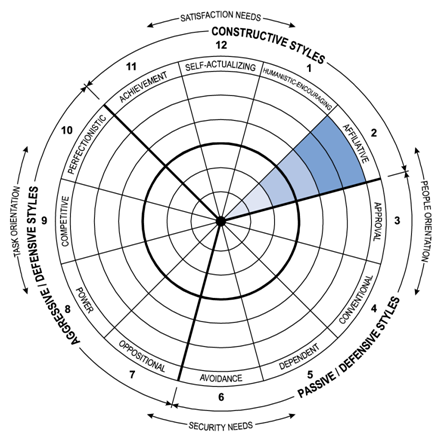In a previous article, we introduced the Human Synergistics Circumplex™, a proven framework to measure, report, discuss and better understand individual and collective human behaviour, and their impact upon business and organisational performance (refer: Catching Smoke: A Proven Framework for Addressing Culture and Leadership).
This latest article focuses on another of the Constructive styles – Affiliative: what it’s all about, how it can contribute to improving your personal effectiveness and the performance of your business/organisation and how to, at a personal and/or workplace culture level, increase Affiliative-oriented thinking and behaviour.

So Just What is the Affiliative Style?
Whether we’re looking at it from an individual leadership or broader workplace culture perspective, the Affiliative style is characterised by a tendency to highly value relationships, be friendly and cooperative, be personally open and warm toward others, and think in terms of mutual benefit/satisfaction.
Leaders high in the Affiliative style will tend to, for example:
- Value their staff and express an interest in their wellbeing and satisfaction
- Work cooperatively with their peers, staff and others
- Value and work to build a sense of team
- Be open, friendly and personable in their interactions with others, and
- Understand that building and maintaining strong relationships contributes positively to their own effectiveness, the effectiveness of their team and the whole organisation.
Workplace cultures can themselves become Affiliative-oriented, with participants feeling expected or implicitly required to, for example:
- Be friendly and cooperative, “get along” with others
- Be warm and engaging
- Show concern for others
- Be effective communicators and have strong interpersonal skills, and
- Think in terms of what’s good for others, and for the broader group/organisation.
So Why Should I Focus on Developing the Affiliative Style?
In both individual leadership and workplace culture contexts, high Affiliative tendencies generate positive outcomes. Indeed, research over several decades by Human-Synergistics has consistently shown that leaders and workplaces cultures high in Affiliative and other Constructive styles tend to be significantly more effective, particularly in the longer-term, than those with predominantly defensive styles.
From a workplace culture perspective for example, primarily Constructive workplaces:
- are 32% more able to effectively respond to changes in the external environment
- achieve 32% higher quality performance
- demonstrate 28% more effective teamwork
- have a 25% greater commitment to producing a quality result
- include individuals that are 32% more motivated, 26% more satisfied and 25% more likely to stay with the organisation.
At an individual level, leaders high in the Affiliative style are generally well-liked by those they interact with, are more satisfied with their relationships with others, and are personally more effective/productive as a result of their strong and cooperative relationships with others.
Developing Affiliative Thinking, Behaviours and Culture
If you think you could improve your effectiveness as a leader by further developing your Affiliative thinking and behaviour, try for example:
- Making a genuine effort to get to know people better. Express a genuine interest in them and ask open-ended questions.
- Be aware of and work to develop positive body language and general communication skills: practice active listening, ask lots of questions, maintain an open stance, smile and maintain eye contact.
- Make an effort to interact with more people and develop your social skills. Perhaps join a new networking, sporting or social group.
- Reflect on how others interact with you. Do they welcome you, smile and engage, or are they tentative, wary? Practice new ways of interacting, reflect on and learn from your experiences.
- Make a conscious effort to build a sense of “team” among your co-workers. Ask for their opinions, share information, express enthusiasm and actively acknowledge their contributions.
To further develop Affiliative expectations at a collective/workplace level, consider:
- Developing and implementing a system or less-formal practice of peer recognition
- Spending more time with people and encouraging others to do the same
- Acknowledging and celebrating individual and team milestones/successes
- Promptly and effectively addressing any improper behaviours of team members that damage relationships or create disharmony, and
- Facilitating/commissioning team training exercises that provide scope for team members to communicate more openly and get to know one another a bit better (training based on Everything DiSC or Harrison Assessment methodologies, for example, can be particularly valuable).
We’ll continue in future articles to look at the what, why and how of other workplace culture and personal leadership styles. In the meantime, be sure to call if you’d like to explore the range of culture and leadership programs we have available to help transform your people, your team and your business/organisation.
If you’ve missed our previous articles on the other styles, be sure to check out our blog – look for the “Focus on Culture and Leadership” series of articles.

